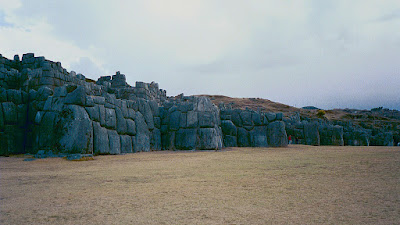10 Oct 2002
Most of the emails I wrote home while travelling are fairly cringeworthy, and my diary entries aren't much better, so I haven't been inclined to quote from them at length. But I like this one enough to reproduce it whole. You'll soon understand why I only have one vaguely decent photo to share.
"Caught a bus from La Paz to a tiny town called Chuñawi. This was one of those old US school buses that are so common in Bolivia. Even had a badge with some US and Canadian town names on the side. These things are designed to sit 33 people, plus one driver. We had 55 people, plus countless children that I missed in the head count, as well as about a tonne of luggage piled on the roof and along the aisle, where it doubled as seating. You should see how athletic some of the old Bolivian ladies are at clambering over such obstacles! I was the only gringo (so got lots of attention - mainly from the old men ... friendly chaps these Andean geriatrics). 6 hour bus ride took 7.5, through some incredible scenery (mountains and valleys higher and deeper than you can imagine).
Got off the bus at my destination, much to the amusement of the remaining passengers (who had, thankfully, thinned out by this stage) - still havn't worked out what was quite so funny, but I grinned along to be amiable." [I distinctly remember a passenger conversing with the bus driver, which looked like: 'What the hell is a gringo doing out here?' 'Going for a walk!' 'Huh?! But why here?' Shrug, 'It's in a book.' Which pretty much sums up the difference in world view between book-educated Westerners and land/oral-educated peasants.]
"Jumped straight onto the start of the trekking route, the Yunga Cruz Trail. As soon as I did so, the Mountain Gods took note, and shouted their buddies the Cloud Gods a few rounds to come and join the party. Anyway, found myself a nice camping spot, and my tent and sleeping bag did themselves proud in the chilly Altiplano night.
Next day, I'm off along the trail. The reason I decided to do this particular trek is that it is supposed to be one of the best trails in the Cordillera Real (that's a mountain range - part of the Andes). Start off nice and high (4000m) and then trek down to what they call the Yungas at 1500m, a cross between mountains and Amazon rainforest. All along the way, one supposedly gets magnificent views and wilderness. Sounded fab to me, but there I was following a trail along the side of a mountain ridge, surrounded by a very well laid on layer of cloud, with visibility down to about 50m. Ah well, it'll clear, right? Hah!
Ran into an old Bolivian fella (another friendly geriatric). He was doing the rounds, feeding his cows a combination of salt and grain to supplement their grass diet. This guy said he was seventy, and he was running around these mountains (in his sandals) in the cold, wind and rain with nary a whimper nor a complaint. He provided some entertainment for the morning, plus reduced my cookie and chocolate supply, something I'm sure he does for all the loco gringos who hike this trail.

That afternoon, the Cloud Gods kept going strong, altough every now and then on rushed off to the toilet to allow for rare moments of tempting views, but never delivering on the real thing. As I descended further, the Mountain Gods put on a keg and invited around their old friends the Mud Gods, who of course don't go anywhere without the Slippery Rocks and Precarious Drops Gods. That night I camped in an area of cloud forest, which is basically high altitude rain forest - very cool, I'm talking major moss-action here. Innsects were going great-guns as well - lets just say Aerogard is something they were afraid of as kiddies, but don't bother them so much anymore.
Next day was loooooong. It just kept goin' and goin' and goin'. The Cloud Gods backed off a little, allowing me some reasonable views, but they were always willing to take a dump on me at irregular intervals. The track kept going, taking a good deal longer than it ought to have, owing mainly to the massive mud puddles through which it strayed. Step. Gulp, slurp, gobble. Yikes! Suuuuuck - POP! Have to say that my boots held up admirably to the abuse, barely a skerrick of moisture made its way in the whole day. After way too long, I emerged from the forest to see my destination right before me, except for a massive gorge which needed to be traversed to get there - one of those ´think you're at the end but you're really hours away so the rest is extra painful´ things.
So, exhausted, I reluctantly made my way through the copius coca plantations that dotted the hillsides. Someone smiled on me, however, as at the bottom of the gorge was the most idyllic of places. With a rampaging stream crossed by a log bridge, I made my way along a path edged by delicate flowers, only to have tens of purty butterflys arise with my passing and fill the air with sweet scented perfume. Ahhh, ain't it just lurvely."
[Also worth noting is that on the way down into that forge I took a wrong turn and nearly ended up at an indigenous settlement which was a no-go zone for outsiders. Luckily I encountered some people who put me on the right path before I made an awkward mistake.]
"So yeah, I caught a bus back to La Paz and here I am. Tomorrow I ride down The Worlds Most Deadliest Road (140 deaths in the last 2 months!) on a mountain bike, and then rumble on to my very own Apocalypse Now in the Bolivian Amazon!"














































